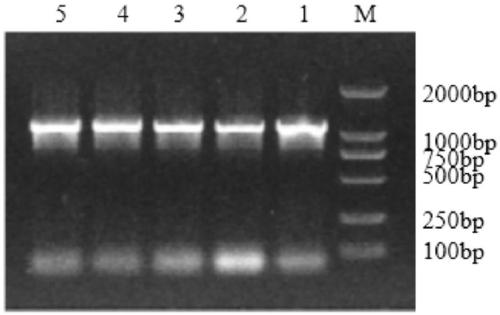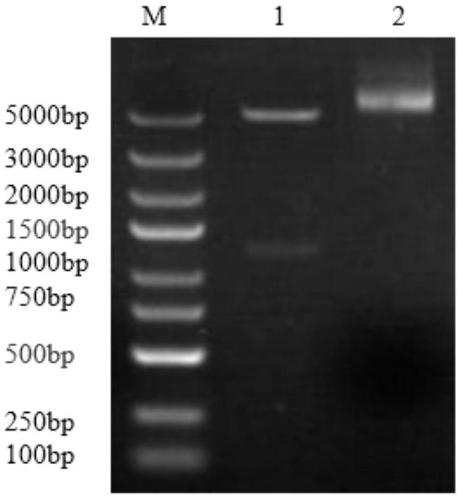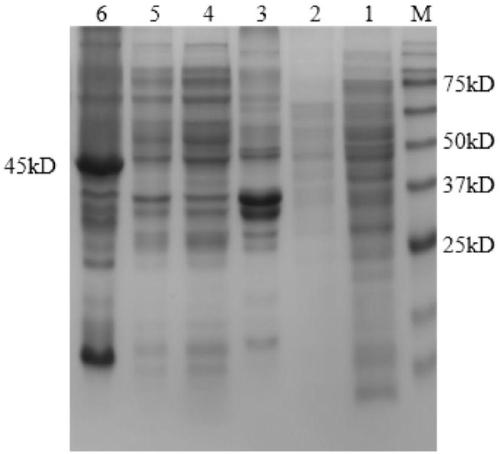Lactobacillus plantarum nitrite reductase gene, protein coded by gene and applications of protein
A technology of Lactobacillus plantarum and nitrite, applied in the field of high-efficiency affinity chromatography purification, the field of recombinant vectors of nitrite reductase gene of Lactobacillus plantarum, can solve the problem of not being able to well identify whether the expression of nitrite reductase is successful, The target product nitrite reductase cannot be obtained in large quantities, and the separation and purification work is complicated.
- Summary
- Abstract
- Description
- Claims
- Application Information
AI Technical Summary
Problems solved by technology
Method used
Image
Examples
Embodiment 1
[0034] The preparation of the genomic DNA of plant lactobacillus nitrite reductase comprises the steps:
[0035] 1. PCR primer design
[0036] PCR primers were designed with the DNA of Lactobacillus nitrite reductase in Genbank:
[0037] The upstream primer (SEQ ID NO.3) is 5-CTCGAGAAAAAGACCATGGCCAA-3 (NcoI),
[0038] The downstream primer (SEQ ID NO.4) is 5-CTTAAGAATCCTGTTTGGAC-3 (XhoI), and this pair of upstream and downstream primers is artificially synthesized;
[0039] 2. Extraction of genomic DNA of Lactobacillus plantarum nitrite reductase (bacterial genomic DNA small purification kit Takara Minibest Bacterial Genomic DNA Extraction Kit Ver.2.0, a product of Takara Biotechnology Company, purchased from Guangzhou Ruizhen Biotechnology Co., Ltd. ), wherein the solution is the solution in the kit, and the specific steps are:
[0040] (1) Centrifuge 3-4 mL of Lactobacillus plantarum culture at 12,000 rpm for 1 min, discard the supernatant, place the bacterial cell pellet...
Embodiment 2
[0064] Containing the construction of the recombinant expression vector of the genomic DNA of the Lactobacillus plantarum NiR of the PCR expansion of the gained of embodiment 1, the steps are as follows:
[0065] The amplified fragment DNA of Lactobacillus plantarum nitrite reductase obtained in Example 1 and the plasmid pET-28a(+) were digested with NcoI and XhoI respectively, and the reaction conditions were overnight at 37°C for 14-16h, and then respectively Fragmented DNA and plasmid DNA were recovered.
[0066] Ligate the above two fragments, and refrigerate overnight at 4°C for 14-16 hours to obtain the ligation product. The ligation reaction system is as follows: 19 μL of pET28a(+) was recovered, 2.5 μL of the target gene fragment was recovered, and 1 μL of T4DNA was ligated. T4 DNA ligase buffer 2.5 μL;
[0067] Then transform the above ligation product into E.coli DH5α cells to obtain the recombinant plasmid pET28a(+)-nir;
[0068] The obtained recombinant plasmid p...
Embodiment 3
[0070] The expression vector pET28a(+)-nir plasmid constructed in Example 2 was transferred into E.coli BL21 competent cells to obtain recombinant Escherichia coli for induced expression. The specific steps are as follows:
[0071] Inoculate the constructed expression strains into LB / Kan liquid medium, culture overnight at 37°C with shaking for 14 hours, then inoculate 1% of the bacterial liquid into Erlenmeyer flasks containing 100mL LB / Kan liquid medium, shake at 37°C After culturing for 4 hours (the OD600 of the bacterial solution reached 0.4-0.6), IPTG was added to make the final concentration 1 mmol / L; at the same time, empty vector and no induction were used as controls. Centrifuge the bacteria solution at 8000r / min for 10min, discard the supernatant, wash the precipitated bacteria twice with PBS buffer (pH7.4), and resuspend the washed bacteria in 10mL pre-cooled PBS buffer (pH7.4 ), sonicate for 10 min, each time for 3 s, with an interval of 5 s, and a power of 200 W. ...
PUM
 Login to View More
Login to View More Abstract
Description
Claims
Application Information
 Login to View More
Login to View More - R&D
- Intellectual Property
- Life Sciences
- Materials
- Tech Scout
- Unparalleled Data Quality
- Higher Quality Content
- 60% Fewer Hallucinations
Browse by: Latest US Patents, China's latest patents, Technical Efficacy Thesaurus, Application Domain, Technology Topic, Popular Technical Reports.
© 2025 PatSnap. All rights reserved.Legal|Privacy policy|Modern Slavery Act Transparency Statement|Sitemap|About US| Contact US: help@patsnap.com



